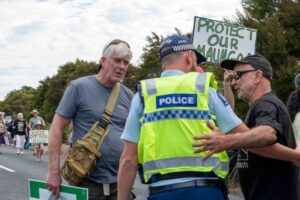Karangahake Gorge residents were “left in the dark” during a prolonged power outage during a recent storm, sparking concerns about safety and a lack of communication.
High winds left nearly 3000 Coromandel Peninsula residents without power on November 11, but power was restored to most homes by 4pm the same day.
However, nearly 300 Karangahake Gorge residents say a lack of communication by Powerco during their 18-hour power outage left them wanting the national electricity distributor to improve its system.
Gorge resident Chris Morgan said she experienced communication issues with Powerco during the prolonged power outage, which meant she had to feed her baby son a cold bottle with infant formula in the middle of the night and she couldn’t cook since her home had no gas supply.
“We must’ve got up at about 2am and we couldn’t heat the water for his bottle so we made a cold bottle and hoped he would take it cold and thankfully he did,” she said.
“I had to take the small fella over to Flat White [Cafe] at Waihī Beach to get something to eat, and my husband went into work, charged up some battery power banks and got some hot water in a flask.”
Chris said there were no updates on the Powerco website when she checked it.
“We didn’t know what to do when the power went off, so we were checking the Powerco website to see if there was an estimated time for the power to come back on, but there were no updates available.
“We have just moved over from Brisbane – we were blindsided, we weren’t expecting it… we weren’t sure who to contact.”
Charlie Beach, who has lived in the gorge for around 20 years, told The Profile Powerco failed to efficiently communicate the power outage to him and other residents.
“This was a very long power cut and perhaps the longest one we’ve had for some time, and when there’s a prolonged power cut, people start to get tetchy and that’s where [Powerco] need to be a bit more precise,” he said.
“They need to be able to tell people where the fault is and what they’re repairing so people have a better idea and they’re not sitting there wondering.
“When you ring up, they’re very vague in their communication, sometimes we’re left in the dark, they say ‘we’re not sure when the power will come on’ and sometimes they might say ‘between four and 10 hours’ – well that’s not good enough.”
Charlie said he had no power at his River Rd address between 1:30pm on November 11, and 10am on November 12.
“We went right through the night with no power, and of course at that stage the freezers were starting to freeze off and the fridges were losing all their coldness.
“We’re prepared when the power goes off, we have a little gas cooker, torches and candles so we can get by with a power cut, but when you ring up to find out how long it’s likely to be, we need to be given better information.
“I worked in the powerboard industry for over 50 years and we made far better contact with our customers in the days of the Thames Valley Electric Power Board and letting people know when the power went off.”
Powerco said the Karangahake Gorge power outage began at 1:15pm on November 11 after high winds blew a tree branch into power lines, cutting power to 285 customers. Power was restored by 9:30am on November 12. At the time, severe weather was battering the Coromandel and Bay of Plenty regions, with heavy rain and high winds causing widespread outages on Powerco’s network.
Powerco Head of Network Operations, Caz Haydon, said because of the high number of weather-related outages at the time, crews were unable to get to the site and restore power until the following morning.
“Although our crews worked into that evening to get to as many outages as they could, for safety reasons we stood them down when it got dark, and they continued repairs at first light the following day.”
The live outage map on Powerco’s website provided the most timely and reliable updates for customers including estimated restoration times, she said.
“We try our best to provide accurate restoration times but during storm events the damage is significant, with many outages having multiple faults that need repairing or replacing,” she said.
“This complexity of repairs means it can take longer than usual for crews to carry out repairs and restore power.”

The power outage began at 1:15pm on November 11 after high winds blew a tree branch into power lines. Photo: GORDON PREECE



